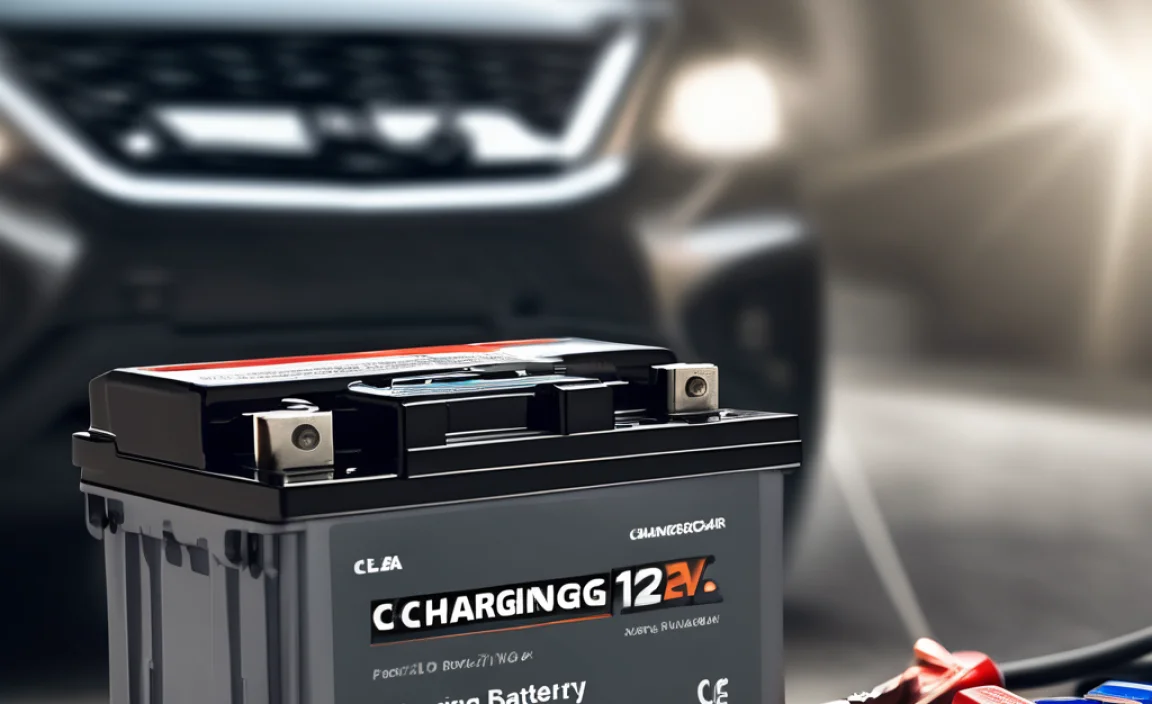Quick Summary: Replacing the battery for your Vivint Motion Sensor is a simple, DIY task that keeps your home security running smoothly. This guide will show you how to find the right battery and swap it out quickly and safely, ensuring your motion sensor is always powered up and ready to protect your home.
Is your Vivint motion sensor chirping or showing a low battery warning? Don’t worry, it’s a common issue that’s easy to fix yourself. This little device is always on guard, making sure your home is safe. When its battery gets low, it sends you a signal so you can swap it out. It might seem a bit technical, but I’m here to break it down into simple steps. You don’t need to be a tech whiz or a professional installer. We’ll cover what you need, how to do it safely, and what to do if you get stuck. Let’s get your motion sensor powered up and your peace of mind restored.
Understanding Your Vivint Motion Sensor Battery
Vivint motion sensors are a key part of your smart home security. They work by detecting movement, usually through infrared technology, and then sending a signal to your Vivint system. To do this, they need a constant power source, which comes from a small but mighty battery. Knowing which battery your specific sensor uses is the first step to keeping it working perfectly.
Most Vivint motion sensors, especially the popular ones like the Vivint Motion Sensor (which is often the standard model included in packages), typically use a CR123A or CR17345 lithium battery. These are common button-cell batteries known for their long life and reliability in low-power electronic devices. However, Vivint has updated its product line, and some newer models or different types of sensors might use a different battery. It’s always best to confirm the exact battery type for your specific device to avoid confusion.
Why Batteries Matter for Your Motion Sensor
Think of the battery as the heart of your motion sensor. Without a good battery, the sensor can’t communicate with your Vivint panel, and it can’t detect any movement. This means:
- Missed Detections: If the battery is dead, the sensor won’t pick up any motion, leaving a gap in your home security coverage.
- False Alarms (Rarely): While less common, a failing battery can sometimes cause erratic behavior.
- System Alerts: Your Vivint system is designed to let you know when a sensor’s battery is low, usually through the app or the main panel. This is a helpful warning to prevent a complete failure.
Replacing the battery is usually a straightforward process that you can do yourself. However, understanding the specifics of your sensor model can make the job even easier and ensure you have the right tools and parts ready. For a deeper dive into battery types and their common uses, resources like the U.S. Department of Energy’s guide on battery technologies can offer a broader perspective on power sources in everyday devices.
Identifying Your Vivint Motion Sensor Model
Vivint offers a range of smart home devices, and sometimes different sensors might have slightly different battery requirements. The most common Vivint Motion Sensor is the one that looks like a white, rounded pyramid or a small, sleek white rectangle. However, if you have other sensors, like glass break detectors or specialized door/window sensors that also detect motion, they might use different batteries.
Here’s how to figure out exactly which sensor you have and what battery it needs:
- Check the Sensor Itself: Many sensors have small labels on the back or inside the battery compartment that indicate the model number and the required battery type.
- Consult Your Vivint Account: Log in to your Vivint account online or through the mobile app. Your device list should show all your installed equipment, often with model numbers.
- Review Your Installation Documents: If you kept the paperwork from your Vivint installation, it will likely list the specific model numbers of your devices.
- Contact Vivint Support: If you’re still unsure, the easiest way is to contact Vivint customer support. They can look up your account and tell you precisely which sensor models you have and what batteries they use.
For the standard Vivint Motion Sensor (often the one referred to when people ask about “Vivint Motion Sensor Battery”), the CR123A lithium battery is the most frequent requirement. These batteries are powerful, long-lasting, and ideal for the continuous operation of motion detection devices.
The Best Battery for Your Vivint Motion Sensor
When choosing a replacement battery for your Vivint Motion Sensor, you want something reliable and long-lasting. As mentioned, the CR123A (also known as a CR17345) is the most common type. These are 3-volt lithium batteries.
Why choose CR123A lithium batteries?
- Long Lifespan: They are designed to last for several years in devices like motion sensors, which don’t draw a lot of power continuously.
- Temperature Resistance: Lithium batteries perform well across a wide range of temperatures, which is important for sensors that might be in unconditioned spaces like garages or basements.
- Reliability: They offer a stable voltage, ensuring your motion sensor operates consistently.
You can find CR123A batteries at most major retailers, electronics stores, and online. When buying, consider reputable brands. While cheaper unbranded options might seem appealing, sticking with well-known brands often ensures better quality and longer performance.
Battery Specifications to Look For:
| Battery Type | Voltage | Chemistry | Common Vivint Sensor Use |
|---|---|---|---|
| CR123A / CR17345 | 3V | Lithium Metal | Most Vivint Motion Sensors |
| Other types (less common) | Varies | Varies | Specific older or specialized sensors |
It’s always a good practice to buy batteries in multi-packs if you have multiple sensors or other devices that use the same type. This is often more cost-effective. For instance, a pack of four or eight CR123A batteries can keep your motion sensors powered for years.
Important Note on Battery Compatibility: While CR123A is standard, Vivint may occasionally update its hardware. Always double-check the specific battery type listed in your sensor’s manual or on the sensor itself to be absolutely sure. For example, some lesser-known smart home sensors might use AA or AAA batteries, but this is rare for Vivint motion detectors.
Step-by-Step: How to Replace Your Vivint Motion Sensor Battery
Replacing the battery in your Vivint motion sensor is a simple DIY task. Follow these steps carefully to ensure a smooth and safe battery change. This process is generally the same for most Vivint motion sensor models, but always refer to your specific sensor’s manual if available.
Tools and Materials You’ll Need:
- Replacement Battery (confirm the type, usually CR123A)
- A small, flathead screwdriver (often for prying open the sensor casing)
- A clean, soft cloth (optional, for cleaning the sensor if needed)
- Your Vivint app or panel to confirm the sensor status
Detailed Replacement Steps:
Step 1: Place Your System in Test Mode
Before you do anything, it’s crucial to put your Vivint system in “Test Mode.” This prevents the sensor from sending a tamper alert or a low battery alert to Vivint monitoring when you remove the old battery. You can usually do this through your Vivint app or by logging into your account on the Vivint website. Select your panel, go to ‘Settings,’ then ‘System,’ and find the ‘Test Mode’ option. Follow the on-screen prompts. This mode usually lasts for a few hours, which is more than enough time.
Step 2: Locate the Motion Sensor
Identify the specific motion sensor you need to replace the battery in. It’s usually the one that has been chirping or showing a low battery alert on your system.
Step 3: Open the Sensor Casing
Most Vivint motion sensors have a casing that needs to be gently pried open.
- Look for a small notch or seam on the side or bottom of the sensor.
- Insert the flathead screwdriver into this notch.
- Gently twist the screwdriver or pry upwards to release the clips holding the casing together.
- Some sensors might have a small screw to remove first. If you see a screw, remove it with a small Phillips head screwdriver before attempting to pry.
Once the clips are loosened, the front cover of the sensor should lift or slide off.
Step 4: Remove the Old Battery
Inside, you’ll see the battery. It’s usually a cylindrical battery.
- Note the orientation of the old battery (positive (+) and negative (-) ends).
- Most batteries can be gently pulled out by hand or by using the screwdriver to carefully lever them out. Avoid using excessive force.
- If the battery is stuck, try gently wiggling it.
Step 5: Insert the New Battery
Take your new CR123A battery.
- Pay close attention to the polarity markings (+ and -) on both the battery and inside the sensor housing.
- Insert the new battery with the positive (+) terminal facing the correct direction as indicated in the sensor.
- The battery should snap into place smoothly. Test Mode should override any immediate alerts from the sensor being active.
Step 6: Close the Sensor Casing
Align the front cover of the sensor with the base.
- Gently press the cover back into place until you hear or feel the clips snap shut.
- Ensure the casing is securely closed.
Step 7: Exit Test Mode and Verify
Go back to your Vivint app or panel and exit Test Mode. The system should now recognize the sensor with its new battery. You can typically confirm this by checking the sensor’s status in your app or panel settings. It should now show as “Online” and have a full battery status. Some sensors might chirp once to indicate they are powered up. If the sensor doesn’t come back online or continues to show a low battery, double-check the battery orientation and ensure it’s seated correctly. If problems persist, you may have a faulty sensor or battery, and it would be time to contact Vivint support.
For additional guidance on DIY smart home maintenance, including battery replacements common in electronics, you might find resources like iFixit’s troubleshooting guides helpful, as they offer practical advice applicable to many electronic devices.
Troubleshooting Common Vivint Motion Sensor Battery Issues
Even with straightforward steps, you might run into a hiccup. Don’t get discouraged; most issues are easily resolved.
Sensor Not Responding After Battery Change:
- Double-Check Battery Orientation: This is the most common mistake. Ensure the positive (+) and negative (-) ends are correctly aligned.
- Confirm the Battery Type: Did you use the correct battery? A CR123A is standard, but verify it aligns with your specific sensor model.
- Inspect Battery Contacts: Ensure the metal contacts inside the sensor are clean and not corroded. You can gently clean them with a pencil eraser or a dry cloth.
- Is the Battery Fresh? Even new batteries can sometimes be faulty. Try a different new battery from your pack.
- Reseat the Battery: Remove the battery and reinsert it firmly.
Sensor Still Showing Low Battery Alert:
- Allow Time for Update: Sometimes, it can take a few minutes for the Vivint system to update the sensor’s status after the battery replacement.
- System Test Mode: Ensure you exited Test Mode properly. If you’re still in Test Mode, the system might not be fully updating communication.
- Sensor Tamper Switch: Make sure the sensor casing is fully closed. There’s often a small “tamper” switch that gets pressed when the cover is on. If it’s not engaged, the system might think the sensor is being interfered with.
- Software Glitch: Try rebooting your Vivint panel by following the instructions in your manual or on the Vivint website. This can sometimes clear communication errors.
Sensor Tamper Alert After Battery Change:
This almost always means the sensor casing is not fully or correctly reassembled. Open it up again and ensure both halves of the casing are snapped together securely all the way around. Check that no internal components are obstructing the closing mechanism.
Frequent Battery Drain:
If you find yourself replacing batteries much more often than expected (more than once a year or two), there might be an underlying issue:
- Environmental Factors: Extreme temperatures can shorten battery life.
- Sensor Placement: Very high-traffic areas might cause the sensor to trigger and transmit more often, using more power.
- Interference: Heavy wireless interference in your home could cause the sensor to retransmit signals, draining the battery faster.
- Faulty Sensor: In rare cases, the sensor itself might have an internal fault causing it to draw excessive power.
If you suspect frequent battery drain, it’s a good idea to contact Vivint support. They can help diagnose potential issues with the sensor or your system’s communication.
Long-Term Battery Care and Best Practices
Taking good care of your Vivint motion sensor batteries ensures your security system is always dependable. Here are some best practices:
- Regular System Checks: Don’t wait for a low battery alert. Periodically check the status of all your sensors through the Vivint app or panel. This proactive approach can prevent unexpected failures.
- Stock Up on Quality Batteries: Keep a few spare CR123A batteries on hand. When purchasing, choose reputable brands. For example, Energizer and Duracell are well-known for their reliability in devices like security sensors. Buying them in bulk from a trusted retailer can offer better value.
- Proper Storage of Batteries: Store spare batteries in a cool, dry place away from direct sunlight and metal objects that could cause them to short circuit. Don’t store them loose in a pocket or bag.
- Dispose of Old Batteries Responsibly: Lithium batteries should not be thrown in regular household trash. Many local waste management facilities or electronics stores have battery recycling programs. You can find more information on proper disposal through resources like the Environmental Protection Agency (EPA).
- Understand Battery Lifespan: The lifespan of a CR123A battery in a Vivint motion sensor typically ranges from 3 to 5 years, but this can vary based on usage, environmental conditions, and battery quality.
- Device Updates: Occasionally, Vivint might release firmware updates for your sensors or panel. Ensure your system is up-to-date, as these updates can sometimes improve battery efficiency.
By following these simple tips, you can maximize the performance and longevity of your Vivint motion sensor batteries, ensuring your home security system remains robust and reliable for years to come.
Frequently Asked Questions (FAQ)
Q1: What kind of battery does a Vivint Motion Sensor use?
A1: Most Vivint Motion Sensors use a CR123A (also known as CR17345) 3-volt lithium battery. It’s always best to check the specific model of your sensor to confirm, as some different or older models might vary.
Q2: How often do I need to replace the battery in my Vivint Motion Sensor?
A2: On average, a CR123A battery in a Vivint Motion Sensor can last between 3 to 5 years. This can vary depending on how often the sensor is triggered, environmental factors like temperature, and the quality of the battery.
Q3: My Vivint Motion Sensor is chirping. What does that mean?
A3: A chirping sound from a motion sensor usually indicates a low battery. Your Vivint system should also send an alert to your app or panel. It’s a sign that the battery needs to be replaced soon.






